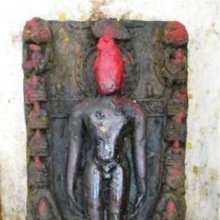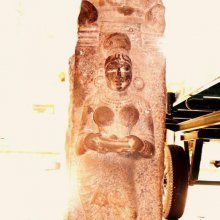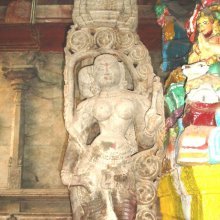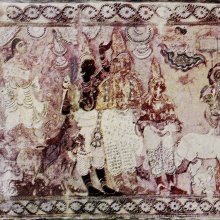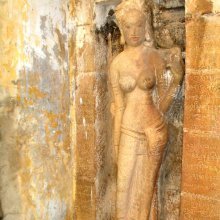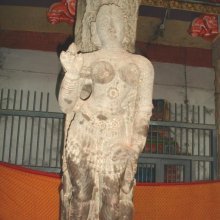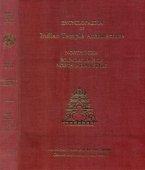Cola, Coḷa, Cōḻa, Colā: 34 definitions
Introduction:
Cola means something in Buddhism, Pali, Hinduism, Sanskrit, Jainism, Prakrit, the history of ancient India, Marathi, Hindi, biology, Tamil. If you want to know the exact meaning, history, etymology or English translation of this term then check out the descriptions on this page. Add your comment or reference to a book if you want to contribute to this summary article.
The Sanskrit term Coḷa can be transliterated into English as Cola or Colia, using the IAST transliteration scheme (?).
Alternative spellings of this word include Chola.
Images (photo gallery)
(+36 more images available)
In Hinduism
Purana and Itihasa (epic history)
Source: archive.org: Puranic Encyclopedia1) Cola (चोल).—A very righteous emperor of Kāñcīpura. Because of the virtuous rule of this emperor his country got the name Cola. There is an interesting story in Padma Purāṇa of how the emperor attained Vaikuṇṭhaloka (The abode of Mahāviṣṇu).
Once Cola went to Vaikuṇṭha to worship Mahāviṣṇu. As he was worshipping him with pearls and flowers of gold a brahmin subject of his came there to worship him with water and Tulasī leaves. The simple offering of Tulasī leaves and flowers by this brahmaṛṣi, Viṣṇudāsa, eclipsed the expensive one by the King and the latter was greatly offended and he rebuked the Brahmin saying that he was a poor man who did not know what devotion to Viṣṇu was. But Viṣṇudāsa did not take the taunt unchallenged. He asked the king to wait and see who would merge with the glowing entity of the Lord earlier. (See full article at Story of Cola from the Puranic encyclopaedia by Vettam Mani)
2) Cola (चोल).—The three celebrated kingdoms of South-India of old were Cola, Pāṇḍya and Cera. References to these will be found in many places in the Purāṇas and a few are given below:—
2) Among those present for the svayaṃvara of Rukmiṇī were the Kings of Cola, Pāṇḍya and Kerala.
2) Descending in order from Turvasu were Varga—Gobhānu—Traiśāni—Karandhama—Marutta—Duṣyanta—Varūtha—Gāṇḍīra. From Gāṇḍīra were born the people of Kerala, Pāṇḍya and Cola. (Chapter 277, Agni Purāṇa).
2) Arjuna conquered the army of the King of Cola. (Śloka 21, Chapter 27, Sabhā Parva).
2) The King of Cola gave gifts to Dharmaputra. (Sabhā Parva, Chapter 52, Śloka 35).
2) When during the great battle Dhṛṣṭadyumna formed the Krauñcavyūha the soldiers from Cola guarded the southern wing. (Śloka 60, Chapter 9, Bhīṣma Parva).
2) Śrī Kṛṣṇa once conquered the land of Cola. (Śloka 17, Chapter 11, Droṇa Parva).
Source: Cologne Digital Sanskrit Dictionaries: The Purana Index1a) Cola (चोल).—A son of Āṇḍira after whom was named the Coladeśa.*
- * Brahmāṇḍa-purāṇa III. 74. 6; Matsya-purāṇa 48. 5.
1b) One of the four sons of Janāpīḍa; his kingdom Colāḥ.*
- * Vāyu-purāṇa 99. 6.
1c) A degraded Kṣatriya clan.*
- * Brahmāṇḍa-purāṇa III. 63. 140; Matsya-purāṇa 114. 46.
1d) (c) a southern country.*
- * Brahmāṇḍa-purāṇa II. 16. 56.
Cola (चोल) is a name mentioned in the Mahābhārata (cf. II.24.20, III.48.18, VI.10.58, VI.46.50) and represents one of the many proper names used for people and places. Note: The Mahābhārata (mentioning Cola) is a Sanskrit epic poem consisting of 100,000 ślokas (metrical verses) and is over 2000 years old.

The Purana (पुराण, purāṇas) refers to Sanskrit literature preserving ancient India’s vast cultural history, including historical legends, religious ceremonies, various arts and sciences. The eighteen mahapuranas total over 400,000 shlokas (metrical couplets) and date to at least several centuries BCE.
Kavya (poetry)
Source: Wisdom Library: KathāsaritsāgaraCola (चोल) is the name of a kingdom that was conquered by Udayana (king of Vatsa) during his campaign to obtain sovereignty over the whole earth, according to the Kathāsaritsāgara, chapter 19. Accordingly, “The Kāverī being crossed by him in his victorious onset, and the glory of the king of the Cola race being surpassed, were befouled at the same time”.
The Kathāsaritsāgara (‘ocean of streams of story’), mentioning Cola, is a famous Sanskrit epic story revolving around prince Naravāhanadatta and his quest to become the emperor of the vidyādharas (celestial beings). The work is said to have been an adaptation of Guṇāḍhya’s Bṛhatkathā consisting of 100,000 verses, which in turn is part of a larger work containing 700,000 verses.
Source: archive.org: The ocean of story, vol. 1Cola (चोल) was the sovereignty of the western part of the peninsula on the Carnatic, extending southwards to Tañjore, where it was bounded by the Pāṇḍyan kingdom. It appears to have been the Regio Soretanum of Ptolemy, and the Cola maṇdala, or district, furnishes the modern appellation of the Coromandel coast (Wilson, Essays, p. 241n).

Kavya (काव्य, kavya) refers to Sanskrit poetry, a popular ancient Indian tradition of literature. There have been many Sanskrit poets over the ages, hailing from ancient India and beyond. This topic includes mahakavya, or ‘epic poetry’ and natya, or ‘dramatic poetry’.
Jyotisha (astronomy and astrology)
Source: Wisdom Library: Brihat Samhita by VarahamihiraColā (चोला) refers to a country belonging to “Dakṣiṇa or Dakṣiṇadeśa (southern division)” classified under the constellations of Uttaraphālguni, Hasta and Citrā, according to the system of Kūrmavibhāga, according to the Bṛhatsaṃhitā (chapter 14), an encyclopedic Sanskrit work written by Varāhamihira mainly focusing on the science of ancient Indian astronomy astronomy (Jyotiṣa).—Accordingly, “The countries of the Earth beginning from the centre of Bhāratavarṣa and going round the east, south-east, south, etc., are divided into 9 divisions corresponding to the 27 lunar asterisms at the rate of 3 for each division and beginning from Kṛttikā. The constellations of Uttaraphālguni, Hasta and Citrā represent the southern division consisting of [i.e., Colā] [...]”.

Jyotisha (ज्योतिष, jyotiṣa or jyotish) refers to ‘astronomy’ or “Vedic astrology” and represents the fifth of the six Vedangas (additional sciences to be studied along with the Vedas). Jyotisha concerns itself with the study and prediction of the movements of celestial bodies, in order to calculate the auspicious time for rituals and ceremonies.
General definition (in Hinduism)
Source: archive.org: Indian Historical Quarterly Vol. 7Cola (चोल) is the name of a country classified as both Hādi and Kādi (two types of Tantrik division), according to the 13th century Sammoha-tantra (fol. 7).—There are ample evidences to prove that the zone of heterodox Tantras went far beyond the natural limits of India. [...] The zones in the Sammoha-tantra [viz., Cola] are here fixed according to two different Tantrik modes, known as Kādi and Hādi.
Source: Oxford Index: HinduismCōḻa: One of the great Tamil dynasties, at its height in South India (and briefly Sri Lanka) between the 9th and 13th centuries ce.
In Buddhism
Theravada (major branch of Buddhism)
Source: Pali Kanon: Pali Proper NamesA country whose people were called Cola. The country extended from the Coromandel coast of South India as far as the Penner River, its capital in mediaeval times being Tanjore. The Ceylon Chronicles mention frequent invasions of Ceylon by the Cola chiefly for purposes of plunder. These invasions were a constant menace to the peace and prosperity of Ceylon, and helped largely in the destruction and disappearance of that countrys literary and artistic works. For details see Mhv. and Cv. passim.
-- or --
The people of Cola.
Theravāda is a major branch of Buddhism having the the Pali canon (tipitaka) as their canonical literature, which includes the vinaya-pitaka (monastic rules), the sutta-pitaka (Buddhist sermons) and the abhidhamma-pitaka (philosophy and psychology).
In Jainism
General definition (in Jainism)
Source: archive.org: Een Kritische Studie Van Svayambhūdeva’s PaümacariuCola (चोल) participated in the war between Rāma and Rāvaṇa, on the side of the latter, as mentioned in Svayambhūdeva’s Paumacariu (Padmacarita, Paumacariya or Rāmāyaṇapurāṇa) chapter 57ff. Svayambhū or Svayambhūdeva (8th or 9th century) was a Jain householder who probably lived in Karnataka. His work recounts the popular Rāma story as known from the older work Rāmāyaṇa (written by Vālmīki). Various chapters [mentioning Cola] are dedicated to the humongous battle whose armies (known as akṣauhiṇīs) consisted of millions of soldiers, horses and elephants, etc.

Jainism is an Indian religion of Dharma whose doctrine revolves around harmlessness (ahimsa) towards every living being. The two major branches (Digambara and Svetambara) of Jainism stimulate self-control (or, shramana, ‘self-reliance’) and spiritual development through a path of peace for the soul to progess to the ultimate goal.
India history and geography
Source: Wisdom Library: India HistoryCola (चोल) is the name of a country included within Dakṣiṇapatha which was situated to the south of the Vindhyas according to the Yādavaprakāśa. Dakṣiṇāpatha is a place-name ending is patha mentioned in the Gupta inscriptions. The Gupta empire (r. 3rd-century CE), founded by Śrī Gupta, covered much of ancient India and embraced the Dharmic religions such as Hinduism, Buddhism and Jainism.
Source: Knowledge Traditions & Practices of India: Architecture (1): Early and Classical Architecture (h)Cola Temples—With the coming of the age of the Imperial Colas who came to power in the 9th century with their capital initially at Tanjavur (Tamil Nadu), Dravidian temple architecture reached its pinnacle. The great temples of the Colas at Tanjavur, Gangaikondacholapuram, Darasuram and Tribhuvanam are standing examples of the height temple architecture of south India had reached. The vimānas are very tall in these four temples. In addition to these grand temples, the Colas constructed numerous others of varying sizes in almost every town and village across their vast empire.
The innumerable sculptures of stone and bronze in the Cola temples are outstanding examples of the skill and dexterity of the artisans of the period and also reflect the patronage given to them by the Cola emperors. It
Source: Cologne Digital Sanskrit Dictionaries: Indian Epigraphical GlossaryCola.—(Chamba), rice. Note: cola is defined in the “Indian epigraphical glossary” as it can be found on ancient inscriptions commonly written in Sanskrit, Prakrit or Dravidian languages.
Source: Ancient Buddhist Texts: Geography of Early BuddhismCoḷa (चोऌअ) or Coḍa is the name of an ancient kingdom of ancient India, as recorded in the Pāli Buddhist texts (detailing the geography of ancient India as it was known in to Early Buddhism).—The Coḷas are mentioned in the Vārtikas of Kātyāyana as well as in the Epics. Coḷa or Coḍa is Tamil Sora and is probably identical with Sora (cf. Sora Regia Arcati) of Ptolemy. The Coḷa capital was Uraiyur (Sanskrit Uragapura); and their principal port was at Kāviripaṭṭanaṃ or Pugār on the northern bank of the Kāverī.
The Coḷas are mentioned in the Vārtikas of Kātyāyana as well as in the Epics. Coḷa or Coḍa is Tamil Sora and is probably identical with Sora (cf. Sora Regia Arcati) of Ptolemy. Yuan Chwang’s record of the Chu-li-ye or Jho-li-ye country is most probably with reference to the Coḷa country, but he describes Chu-li-ye as a wild jungle region.
Source: Shodhganga: Elements of Art and Architecture in the Trtiyakhanda of the Visnudharmottarapurana (history)Cola refers to a certain period in the history of Indian Art.—The chronological order of the development of Indian Art as stated in The Heritage of Indian Art is as follows—[...] 15. Thanjavur is the capital of Colā dynasty. The temples of Thanjavur and Maadurai are the greatest contribution of Colā dynasty.

The history of India traces the identification of countries, villages, towns and other regions of India, as well as mythology, zoology, royal dynasties, rulers, tribes, local festivities and traditions and regional languages. Ancient India enjoyed religious freedom and encourages the path of Dharma, a concept common to Buddhism, Hinduism, and Jainism.
Biology (plants and animals)
Source: Google Books: CRC World Dictionary (Regional names)Cola in India is the name of a plant defined with Casuarina equisetifolia in various botanical sources. This page contains potential references in Ayurveda, modern medicine, and other folk traditions or local practices It has the synonym Casuarina litorea L. ex Fosberg & Sachet, nom. illeg. (among others).
Example references for further research on medicinal uses or toxicity (see latin names for full list):
· Flora Reipublicae Popularis Sinicae (1982)
· Amoenitates academicae (1759)
· Casuarinaceae.
· Allg. Naturgesch. (1841)
· Herb. Amboin. (1743)
· Smithsonian Contributions to Botany (1975)
If you are looking for specific details regarding Cola, for example diet and recipes, health benefits, extract dosage, chemical composition, side effects, pregnancy safety, have a look at these references.

This sections includes definitions from the five kingdoms of living things: Animals, Plants, Fungi, Protists and Monera. It will include both the official binomial nomenclature (scientific names usually in Latin) as well as regional spellings and variants.
Languages of India and abroad
Pali-English dictionary
Source: BuddhaSasana: Concise Pali-English Dictionarycoḷa : (m.) cloth.
Source: Sutta: The Pali Text Society's Pali-English DictionaryCola, (& coḷa) (Cp. Sk. coḍa) a piece of cloth, a rag S.I, 34; J.IV, 380; Miln.169; PvA.73; Sdhp.396. —bhisi a mat spread with a piece of cloth (as a seat) Vin.IV, 40. ‹-› duccola clad in rags, badly dressed Vin.I, 109; III, 263. (Page 273)

Pali is the language of the Tipiṭaka, which is the sacred canon of Theravāda Buddhism and contains much of the Buddha’s speech. Closeley related to Sanskrit, both languages are used interchangeably between religions.
Marathi-English dictionary
Source: DDSA: The Molesworth Marathi and English Dictionarycōlā (चोला).—m (Or cōḷā) The body (opp. to the skirts) of a garment.
--- OR ---
cōḷa (चोळ).—f (cōḷaṇēṃ To rub &c.) Loss by rubbing (as of grain carried in sacks on bullocks). 2 Wastage by use; wear and tear (of things gen.) 3 Inflammation or increase (of a sore) by rubbing and squeezing. v bhara. 4 Laxly. Beaten or frequented state (as of a road or town): the treading and trampling (as of cattle among standing corn): also trodden and trampled state (of the corn).
--- OR ---
cōḷā (चोळा).—m (cōla S) The body (opp. to the skirts) of a garment.
Source: DDSA: The Aryabhusan school dictionary, Marathi-Englishcōlā (चोला).—m The body of a garment.
--- OR ---
cōḷa (चोळ).—f Loss by rubbing. Wastage by use. Inflammation by rubbing. Beaten state.
Marathi is an Indo-European language having over 70 million native speakers people in (predominantly) Maharashtra India. Marathi, like many other Indo-Aryan languages, evolved from early forms of Prakrit, which itself is a subset of Sanskrit, one of the most ancient languages of the world.
Sanskrit dictionary
Source: DDSA: The practical Sanskrit-English dictionaryCola (चोल).—m. (pl.) [cul karmaṇi ghañ]
1) Name of a country in southern India, the modern Tanjore.
-laḥ, -lī 1 A short jacket, a bodice.
2) A garment reaching to the feet.
-lam A garment.
Derivable forms: colaḥ (चोलः).
Source: Cologne Digital Sanskrit Dictionaries: Shabda-Sagara Sanskrit-English DictionaryCola (चोल).—mf. (-laḥ-lī) A short jacket, a bodice. m.
(-laḥ) or m. plu.
(-lāḥ) A country, the modern Tanjore, the name is also supposed to apply to a part of Birbhum in Bengal. E. cul to be high or to elevate, affix ac and la being changed to ḍa coḍa ut sup. or cola a proper name, that of the king of the country applied to the country, or cula karmaṇi ghañ .
Source: Cologne Digital Sanskrit Dictionaries: Benfey Sanskrit-English DictionaryCola (चोल).—and colaka cola + ka, m. pl. The name of a people, [Rāmāyaṇa] 4, 41, 18; [Kathāsaritsāgara, (ed. Brockhaus.)] 19, 95.
Source: Cologne Digital Sanskrit Dictionaries: Cappeller Sanskrit-English DictionaryCola (चोल).—[masculine] jacket, bodice; [plural] [Name] of a people.
Source: Cologne Digital Sanskrit Dictionaries: Monier-Williams Sanskrit-English Dictionary1) Cola (चोल):—m. (= coda) a jacket, bodice, [Naiṣadha-carita xxii, 42] (ifc. f(ā). ; [varia lectio])
2) [plural] Name of a people in southern India on the Coromandel (= cola-maṇḍala) coast, [Mahābhārata ii, vi ff.; Harivaṃśa 782 and 9600; Rāmāyaṇa iv, 41, 18; Varāha-mihira’s Bṛhat-saṃhitā] etc.
3) sg. the ancestor of the Colas, [Harivaṃśa 1836]
4) a prince of the Colas, [Mahābhārata ii, 1893; Padma-purāṇa v, 153 f.; Rājataraṅgiṇī i, 300]
5) n. (= cela) garment, [cf. Lexicographers, esp. such as amarasiṃha, halāyudha, hemacandra, etc.]
Source: Cologne Digital Sanskrit Dictionaries: Yates Sanskrit-English DictionaryCola (चोल):—[(laḥ-lī)] 1. m. 3. f. A short jacket. m. plu. A country, Tanjore.
Source: DDSA: Paia-sadda-mahannavo; a comprehensive Prakrit Hindi dictionary (S)Cola (चोल) in the Sanskrit language is related to the Prakrit word: Cola.
[Sanskrit to German]
Sanskrit, also spelled संस्कृतम् (saṃskṛtam), is an ancient language of India commonly seen as the grandmother of the Indo-European language family (even English!). Closely allied with Prakrit and Pali, Sanskrit is more exhaustive in both grammar and terms and has the most extensive collection of literature in the world, greatly surpassing its sister-languages Greek and Latin.
Hindi dictionary
Source: DDSA: A practical Hindi-English dictionaryColā (चोला) [Also spelled chola]:—(nm) a long robe, gown; appearance; physical frame, body; —[badalanā] to effect a metamorphosis, to change one’s appearance; to change the physical frame; to be reborn.
...
Prakrit-English dictionary
Source: DDSA: Paia-sadda-mahannavo; a comprehensive Prakrit Hindi dictionaryCola (चोल) in the Prakrit language is related to the Sanskrit word: Cola.
Prakrit is an ancient language closely associated with both Pali and Sanskrit. Jain literature is often composed in this language or sub-dialects, such as the Agamas and their commentaries which are written in Ardhamagadhi and Maharashtri Prakrit. The earliest extant texts can be dated to as early as the 4th century BCE although core portions might be older.
Kannada-English dictionary
Source: Alar: Kannada-English corpusCōla (ಚೋಲ):—[noun] the spirit of a person conceived as wandering among or haunting living persons occupying another dead person’s body; a kind of ghost.
--- OR ---
Cōla (ಚೋಲ):—
1) [noun] = ಚೋಲಿ [coli].
2) [noun] a short, defensive jacket.
--- OR ---
Cōḷa (ಚೋಳ):—
1) [noun] one of the erstwhile Tamil countries, now a part of Tamil Nadu, in South India; the Coromandel coast.
2) [noun] any of the kings of that country.
3) [noun] a horse bred in that country.
--- OR ---
Cōḷa (ಚೋಳ):—[noun] = ಚೋಲ [cola]2.
--- OR ---
Cōḻa (ಚೋೞ):—[noun] = ಚೋಳ [cola]1.
Kannada is a Dravidian language (as opposed to the Indo-European language family) mainly spoken in the southwestern region of India.
Tamil dictionary
Source: DDSA: University of Madras: Tamil LexiconCōlā (சோலா) noun cf. cōla. A kind of corset; முலைக்கச்சுவகை. [mulaikkachuvagai.] Pond.
Tamil is an ancient language of India from the Dravidian family spoken by roughly 250 million people mainly in southern India and Sri Lanka.
Nepali dictionary
Source: unoes: Nepali-English DictionaryColā (चोला):—n. 1. body; 2. birth; life; 3. a blouse;
Nepali is the primary language of the Nepalese people counting almost 20 million native speakers. The country of Nepal is situated in the Himalaya mountain range to the north of India.
See also (Relevant definitions)
Starts with (+72): Col-akupeyar, Col-aripul, Cola acuminata, Cola attiensis, Cola cordifolia, Cola de ardilla, Cola de caballo, Cola de faisan, Cola de quiquincho, Cola de venado, Cola de zorra, Cola de zorra africana, Cola de zorra rhodesiana, Cola de zorrillo, Cola del borrego, Cola greenwayi, Cola lateritia, Cola laurifolia, Cola lepidota, Cola nitida.
Ends with (+29): Abata cola, Acantholippia deserticola, Agoseris monticola, Albizia arenicola, Anapayacola, Anaphalis morrisonicola, Anemone rupicola, Angelica morrisonicola, Ardhacola, Aristida monticola, Bidens andicola, Capkon cola, Caracola, Chamaecrista lateriticola, Cincola, Cindhacola, Cindhyacola, Cindicola, Cistanche deserticola, Colacola.
Full-text (+621): Coda, Colatecam, Colaka, Sola, Ratisena, Colonduka, Sumala, Nicola, Colanatu, Chola, Ko-cen-kat-colanayanar, Anuradhapura, Colarattha, Coliya, Colar, Calukya, Cayan-konta-colamantalam, Pandya, Colattattu, Colaccoru.
Relevant text
Search found 83 books and stories containing Cola, Coḷa, Cōḻa, Colā, Cōlā, Cōḷa, Cōḷā, Cōla, Sola, Solaa, Saolaa, Chola; (plurals include: Colas, Coḷas, Cōḻas, Colās, Cōlās, Cōḷas, Cōḷās, Cōlas, Solas, Solaas, Saolaas, Cholas). You can also click to the full overview containing English textual excerpts. Below are direct links for the most relevant articles:
Temples in and around Madurantakam (by B. Mekala)
Later Cholas (in Chengalpattu) < [Chapter 1 - Historical Backdrop]
Transition of Tondaimandalam from the Pallavas to the Cholas < [Chapter 1 - Historical Backdrop]
Political History (3): Karikala < [Chapter 1 - Historical Backdrop]
Later Chola Temples (by S. R. Balasubrahmanyam)
Introduction < [Chapter XI - Kulottunga III (a.d. 1178 to 1218)]
Temples in Kendatti < [Chapter VIII - Temples of Rajaraja II’s Time]
Temples in Elavanasur (Iraivanaraiyur) < [Chapter II - Temples of Kulottunga I’s Time]
The history of Andhra country (1000 AD - 1500 AD) (by Yashoda Devi)
Part 24 - The Telugu Cholas of Nellore (A.D. 1100-1350) < [Chapter XX - The Telugu Cholas (Chodas)]
Part 14 - Vijayaditya (A.D. 1150 or 1157-1182) < [Chapter XII - The Pallavas]
Part 20 - Vijayagandagopala (A.D. 1250-1285) < [Chapter XII - The Pallavas]
Early Chola Temples (by S. R. Balasubrahmanyam)
Temples in Arunachalesvarar (Tiru-Annamalaiyar) < [Chapter X - Historical Survey]
Seven-storeyed Gopuram: Chidambaram < [Chapter XIII - Prasada: Component Parts]
Middle Chola Temples (by S. R. Balasubrahmanyam)
Amman Shrine < [Tanjavur/Thanjavur (Rajarajesvaram temple)]
Temples in Vikkanampundi < [Vijayalaya]
Temples in Malurpatna < [Chapter II - Temples of Rajaraja I’s Time]
Sanskrit sources of Kerala history (by Suma Parappattoli)
4. Pradyumnabhyudaya by Ravivarma Kulasekhara < [Chapter 5 - Sanskrit Dramas and Campus bearing on Kerala History]
2. Kerala in the Puranas < [Chapter 6 - Miscellaneous Sanskrit works bearing on Kerala history]
1.5. The settlements of Kerala with people < [Chapter 2 - Historical details from Mahatmyas and Prashastis]
Related products
